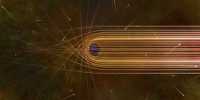Coronal loops on the Sun are one of the most beautiful things we can see on our star. The corona is the solar upper atmosphere, where thin strands of extremely hot plasma ascend from the Sun’s surface. A new research has made an outlandish recommendation. There aren’t all of those structures, and what we see is only a trick of the light. Dr. Anna Malanushenko and her colleagues presented the strange results of a simulation of the Sun in a study published in The Astrophysical Journal. Computer models are frequently used to investigate things we can’t see in person, and the simulation utilized here has already been used to explain various solar phenomena by effectively duplicating them.
When the crew looked into coronal loops, they didn’t expect to uncover anything extraordinary. These dazzling arcs of material have been seen in so many photographs in ultraviolet light, and hypotheses have proposed that they are thin, long, magnetized tubes of plasma forming luminous loops. The simulation generates images with these tiny structures, but when the scientists examined them in 3D, everything changed. The majority of the strands are missing, despite the fact that they appear to be in the system’s two dimensions. They’re made by the overlapping intensity of plasma that’s not limited in tiny tubes, but rather dispersed in a large and more spread-out structure, similar to a veil. Not every loop is like that, but it could be any loop.

“The paper’s main point isn’t that every coronal loop is a crease in the veil. The implication is that each of them may be a veil, and we wouldn’t know,” said Malanushenko, a scientist with the National Center for Atmospheric Research’s High Altitude Observatory. “We need to measure the solar corona differently, thus the coronal veil theory is vital.” So, how did these observations happen? This, according to Malanushenko, is not a simple task. Her team is developing a statistical method that might show whether we’re looking at a veil or individual strands, but it’s still early days. Other researchers, she believes, may have other techniques to validate or reject this notion.
“I’d want to start a community conversation about how to best tackle this,” Malanushenko told IFLScience. “This is broader than a problem for just one organization.” Malanushenko has spent her whole career researching coronal loops, therefore the simulation’s conclusions – that they may not be what we believed – triggered significant emotions in her.
“I’m miserable and ecstatic at the same time.” I’m depressed since this approach might have unintended consequences for a large number of past investigations. “I’m also delighted because that implies we’ll have to create some new methodologies, and whenever we do, we might be able to make a breakthrough in our understanding of the Sun,” Malanushenko told IFLScience. “I’m really looking forward to seeing what happens!”
















